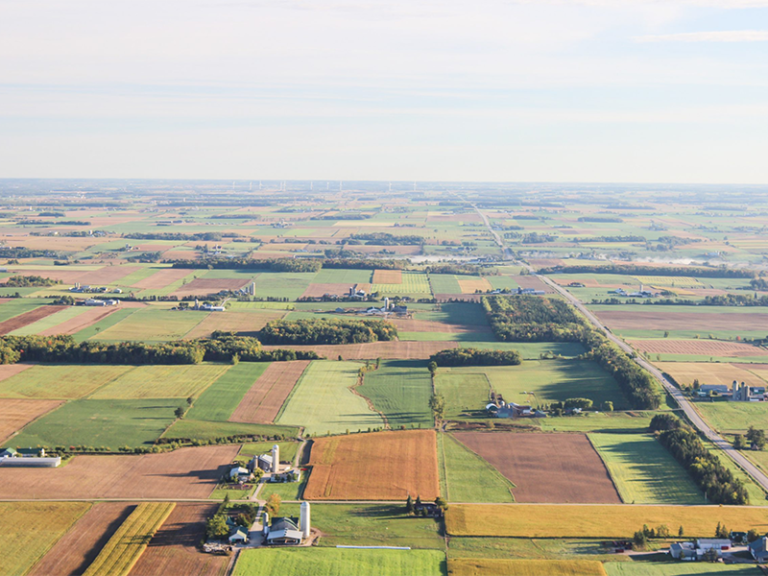First published: November 12, 2004
by Keith Oliver
This is the tenth in a series of articles about planning the growth and
development of human settlements including Area C at the northeast corner
of Cobourg. In 30 years, when this two square mile, or 500 hectare area is
fully developed, Cobourg will be twice its present size.
The provincial government endorses compact urban form.
The need to use land more efficiently and to achieve a more compact urban
form for human settlements in Ontario, is now recognized by the new
provincial government as urgent. By 2031, the population of the area from
Northumberland to Niagara will increase by 45%, or four million people, and
both traffic congestion and property taxes are already high enough. The
Government has recognized that maintaining present land-use planning
practices is no longer acceptable.
Over its 27 kilometre length through Toronto, the 401 highway competes with
the San Bernardino Expressway in Los Angeles County, for the honour of
being the world’s most heavily used highway. Study after study confirms
that building more roads only induces more traffic and is a foolhardy and
unnecessarily expensive attempt at finding a solution.
The real solution to traffic congestion lies in its cause, which is the way
we use land. If development is directed to achieve transit-supportive
land-use, including higher residential and job densities, congestion will
decline. Allow low-density automobile-dependant development to continue,
and congestion, property taxes and the cost of living will continue to
increase.
The provincial government is emphasizing these new urban planning
objectives in its “Places to Grow” report on a yet-to-be-designed 30 year
plan for regional inter-urban infrastructure. It will promote
transit-supportive land-use planning within urban areas, and
transportation-supportive regional land-use planning between urban areas.
Roadways and train tracks are seen as the effective means of directing
growth that they once were.
In a section on strategies for urban centres, the report recommends that
the plan include “…standards and performance measures including jobs,
transit ridership, density targets, and targets for a range of affordable
and appropriate housing choices.”
New high density housing is an important element in the housing mix.
The success of achieving a more compact urban form will be decided by
whether or not a majority of the public will be attracted to the benefits
resulting from higher residential densities. The challenge is to design new
three and four story housing types that offer privacy, private outdoor
space, and many other advantages that single family homes do not.
The minimum average residential density that begins to define compact urban
form is 36 dwellings per hectare (dph). This figure, endorsed by an
American professional association as reputable as the Institute of
Transportation Engineers (ITE), is the universally accepted minimum average
residential density deemed necessary to support attractive, efficient and
affordable public transit. It is also the minimum residential density
necessary to establish walkable neighbourhoods with a real neighbourhood
centre.
Since the acceptable maximum dph for single family homes is 12, and the
acceptable maximum for semi-detached homes is 24 dph, a mix of 30% singles,
30% semi-detached, and 40% new housing types that achieve at least 60 dph
would be necessary to achieve the 36 dph average. The success of the mix
would be based on more housing choice and better access to high quality
public open space while maintaining individual and family privacy,
including private gardens.
The 4 Storey Terraced-Garden Apartment.
One housing type that achieves this at a site density of 75 dph is the 4
Story Terraced-Garden Apartment. With parking included inside the building
on the lowest level, and depending on whether or not the building is built
on a slight slope, or the garage level is located below grade when sited on
a level surface, there may or may not be a need for an interior elevator.
The building type offers a variety of one and two story apartments ranging
from 600 square foot (sf) one bedroom apartments, to 1625 sf four bedroom
units. Outdoor terraced gardens that are open-to-the-sky, vary in size from
325 sf to 900 sf and can include bushes and low trees. The floor of the
gardens consists of modular redwood panels that can be removed to clean
drains or place large planters. To ensure privacy between neighbours, wide
planting boxes are built along the edges of one’s terraced garden that
overlook a neighbour’s garden below.
The post-war European pre-caste construction system.
Producing building components in an organized factory setting increases
productivity by a factor of four compared with traditional on-site
construction. The building type is ideally suited to being constructed
using pre-caste concrete panels produced on site by a simple moveable
factory. This system was widely used in Europe, following the Second World
War, when much of Europe’s urban housing lay in bombed-out ruins and there
was no shortage of rubble. The Cherry Hill Apartment complex on Oxford
Street in London, Ontario, was built following the war using such a panel
system. The complex consists of 13, nine to 17 story high-rise apartment
buildings containing 2200 apartments and has a zero vacancy rate. The plant
that produced the panels is still located several hundred yards to the West
and now serves as a maintenance facility.
The next article will describe the Bedford Glenn development located on
Avenue Road in Toronto, just South of the 401, which contains a modified
Terraced-Garden Apartment building, and which in combination with town
houses, achieves a site residential density of 40 dph.
Note: Part 10


